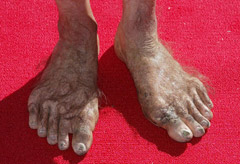Remains are proof that ‘hobbits’ existed
The foot bones have unusual features suggestive of new human species

The foot bones have unusual features suggestive of new human species
A miniature species of extinct humans, nicknamed ‘hobbits’, possessed unusual anatomical features explained by their complete isolation from the rest of humanity for thousands of years on their remote island home in Indonesia, studies have found.
The tiny people, who grew to an adult height of no more than three feet, astounded scientists in 2004 when a skull and partial skeletons were unearthed from a cave on the island of Flores.
Radiocarbon dating suggested that the species, Homo floresiensis, had lived in and around the cave for tens of thousand of years before dying out about 17,000 years ago.
The latest research into H. floresiensis has found that they were flat-footed, long-toed creatures who could walk easily on two legs but would have found it difficult to run at speed. A separate study suggests that their very small heads, which were perfectly in proportion to their bodies.
Two studies published in the journal Nature also cast further doubt on the idea that the hobbits were ordinary people suffering from some kind of pathological condition, such as microcephaly – when the skull fails to grow normally. Many scientists believe there is now little doubt that the hobbits were indeed a human species who had evolved as a result of island dwarfism, when larger animals gradually become smaller over the generations.
‘That evidence has been overwhelming for some time now. Our study provides additional and unequivocal confirmation that we're dealing with a new species. The pathology debate is officially over,’ said Professor Bill Jungers of Stony Brook University in New York, who led the study into the hobbit's foot bones.
Marie Claire Newsletter
Celebrity news, beauty, fashion advice, and fascinating features, delivered straight to your inbox!
‘Their big toe was surprisingly short and more similar to a chimpanzee's in relative length than to humans. However, like chimpanzees again, the free parts of the lateral toes were relatively very long and the bones within were curved, whereas human toes in this region are short and straight,’ Professor Jungers said.
CLICK HERE FOR MORE WORLD NEWS
The leading destination for fashion, beauty, shopping and finger-on-the-pulse views on the latest issues. Marie Claire's travel content helps you delight in discovering new destinations around the globe, offering a unique – and sometimes unchartered – travel experience. From new hotel openings to the destinations tipped to take over our travel calendars, this iconic name has it covered.
-
 Feeling inspired by the London Marathon? 10 science-backed pieces of running advice for beginners
Feeling inspired by the London Marathon? 10 science-backed pieces of running advice for beginners"Remember, running is for everyone - you included."
By Rebecca Shepherd
-
 After the perfect wedding mascara? I've tested over a hundred formulas—these are the ones I'd recommend
After the perfect wedding mascara? I've tested over a hundred formulas—these are the ones I'd recommendAll the length, volume and lift you could ask for
By Denise Primbet
-
 Anatomy Of A Wardrobe: TV presenter AJ Odudu is carving out her own lane, one show-stopping look at a time
Anatomy Of A Wardrobe: TV presenter AJ Odudu is carving out her own lane, one show-stopping look at a timeWatch as we take an exclusive look inside AJ's wardrobe
By Lily Russo-Bah